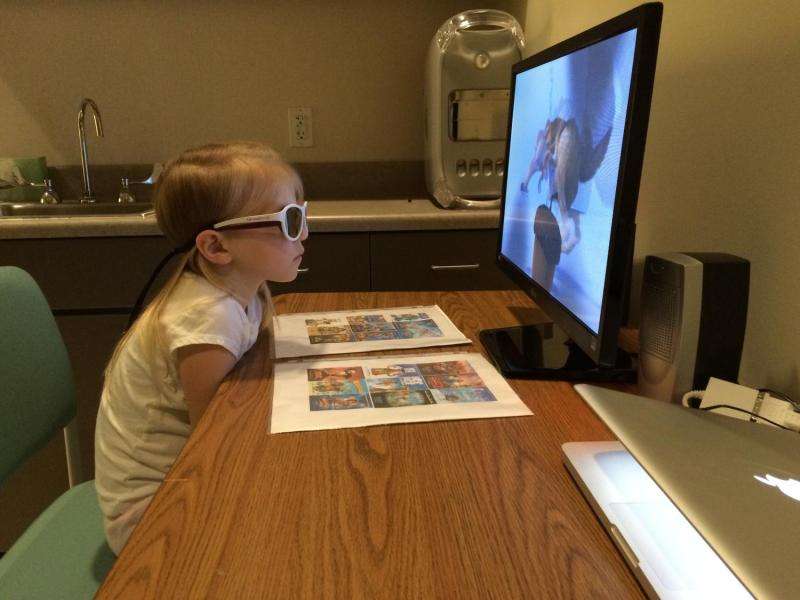A girl with amblyopia watching one of the dichoptic movies on a passive 3-D display while the child wore 3-D cinema glasses. Movie scenes were separated into irregular blob-shaped areas that were complementary for the amblyopic and fellow eyes so that the entire scene could only be perceived if binocular vision was used to merge the parts of the picture shown to each eye. Images were presented at high contrast to the amblyopic eye and low-contrast image to the fellow eye. The contrast-imbalance overcomes suppression of the amblyopic eye and reveals binocular vision. Credit: Retina Foundation of the Southwest
Amblyopia, commonly known as "lazy-eye," has been classically treated by patching the strong eye to force the weaker eye to be used. However, the concept of binocular dysfunction, in which the brain suppresses the image from the weaker eye in favor of the stronger eye, has motivated new approaches to amblyopia treatment. In a new report published in the Journal of the American Association for Pediatric Ophthalmology and Strabismus (AAPOS), researchers describe how the use of dichoptic therapy, which presents different images to each eye separately, combined with popular children's movies, has produced improved visual acuity in young children.
Dichoptic techniques combined with perceptual-learning tasks or simple games have been shown to improve visual acuity significantly in amblyopia. However, children find these tasks intensive and repetitive, and up to 40% of unsupervised patients are noncompliant. A multicenter team of researchers investigated a potentially more engaging method by using popular animated movies with complementary dichoptic stimulation to hold children's interest.
"If the feature film approach has efficacy similar to the contrast-balanced perceptual learning tasks and games in this proof-of-concept study, it may lead to home-based binocular amblyopia therapy with greater compliance," noted lead investigator Eileen E. Birch, PhD, of the Retina Foundation of the Southwest, and the UT Southwestern Medical Center, Dallas, TX.
In the study eight amblyopic children 4-10 years of age watched three dichoptic movies per week for two weeks. Each eye was presented with an image with irregularly shaped blobs that masked different portions of the film. The blobs seen by one eye were the inverse of the blobs seen by the other, so that the entire screen could only be perceived with binocular vision. In order to overcome suppression and allow binocular vision to form a complete picture, the image presented to the stronger eye was reduced in contrast.
Visual acuity improved in the eye with amblyopia in this study. "Children achieved 1-4 lines of improvement in visual acuity with just six sessions (nine hours) of dichoptic (both eyes looking at target at same time) movie viewing over two weeks," explained Dr. Birch. "Patching, by comparison, requires 120 hours of treatment to achieve 1 line of improvement in amblyopic children who have already been treated with spectacles for 12-16 weeks."
While the maximum improvement or the persistence of the improvement remains to be determined, Dr. Birch added, "If these preliminary results are confirmed in a controlled clinical trial, passive viewing of dichoptic feature films could be useful as a primary, supplemental, or maintenance treatment for amblyopia."
More information: "Dichoptic movie viewing treats childhood amblyopia," by Simone Li, PhD; Alexandre Reynaud, PhD; Robert F. Hess, PhD; Yi-Zhong Wang, PhD; Reed M. Jost, MS; Sarah E. Morale, BS; Angie De La Cruz, BS; Lori Dao, MD; David Stager Jr., MD; and Eileen E. Birch, PhD, DOI: dx.doi.org/10.1016/j.jaapos.2015.08.003. It appears in the Journal of AAPOS, Volume 19, Issue 5 (October 2015)
Journal information: Journal of AAPOS
Provided by Elsevier




















